The Cycle of Change is an idea designed to promote regional revitalization by linking economic activities and social relationships. We shared that concept with people living in a specific region and they helped us with field research and shooting a concept video. It’s an attempt to trace a future together with citizens by fusing concept design and research.
Cycle of Changeは、経済的行為と社会的関係をつなげる地域活性化のためのアイデアです。私たちは、そのコンセプトを現実の地域に暮らす人々と共有し、彼らにフィールド調査と映像づくりに協力していただきました。デザインとリサーチの融合を通じて、市民とともに未来を描く試みです。
The Cycle of Change idea was created by Hitachi’s Design Vision Project to bring back the face-to-face economy. It depicts a system in a small-town street lined with small shops in which we encouraged stores to channel the “change” from customers’ shopping into funds to help revitalize the local community whereby residents and shops mutually support each other to inject more life back into the town. The concept video theme seeks to address the challenge of regional decline while forging a sense of shared trust in the community.

The Cycle of Change idea reflects the Vision Design Project’s concept of what a town that enables people to live joyfully would look like. We believe that public spaces that anyone can go to, such as squares, parks, streets, and sidewalks are important elements that contribute to the peace of mind and happiness of people living in towns and cities. Nurturing the formation of mutually considerate, friendly relationships in lively public spaces can greatly improve the quality of city life. Streets in particular are not simply transit points for movement, but also places where strangers can build mutual trust.
Having said that, some streets around the world are in crisis as people stop shopping in the area or new buildings drive out smaller shops. If we lose the opportunity to form social relationships through face-to-face shopping, then our towns and cities will become less enjoyable. The Cycle of Change aims to help small shops make their streets more vibrant and support the sharing of trust in the community.
The Cycle of Change concept video was filmed in Odiham, a small town in Hampshire, England, southwest of London. Odiham boasts a concentrated group of shops on its high street which is comparable to the regional shopping street we envisaged for Japan.
Most towns in the UK have a high-street thoroughfare lined with retail stores. High streets are often considered to be in decline due to the impact of shopping centers and online shopping or to have lost their individuality due to the prevalence of chain stores, but there is a movement to review and preserve the social role of the high street.
The preparations for our shoot sparked the interest of local cafes, restaurants, clothing stores, gift shops, and other commercial enterprises who sympathized with the concept and decided to cooperate with the filming. That’s why we decided to adjust our plans and create a citizen-participation vision that combines design and research. In other words, an approach to developing a region’s future through research and grassroots dialogue.
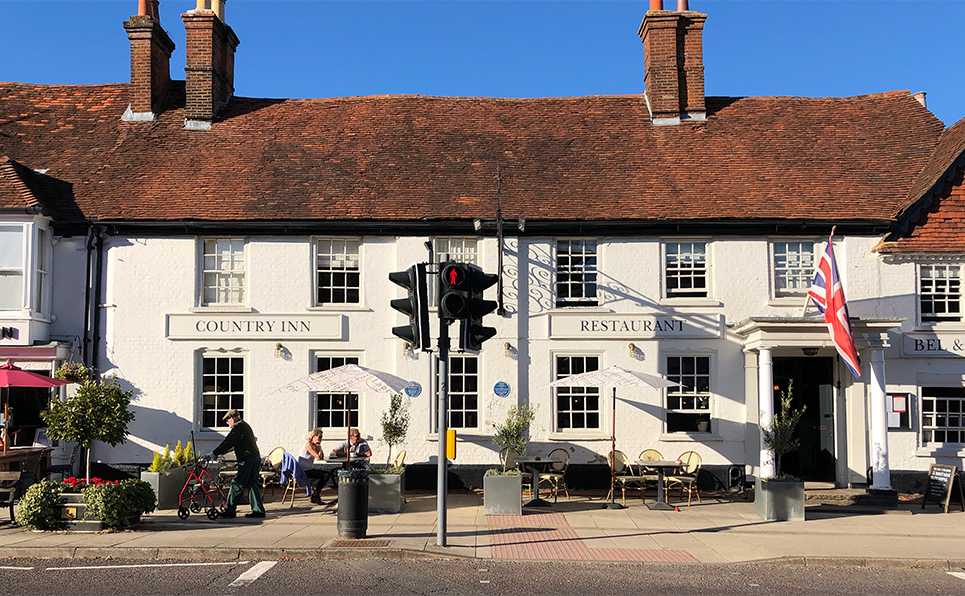
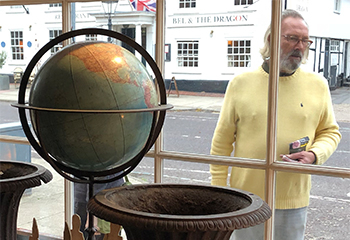
“Odiham is a quintessentially English town. It is Old Britain itself. The town’s old people are also very polite. People get to enjoy small village life with a farm and a house, two kids and two dogs. I’ve run an antiques shop here for five years now and Odiham is very special and beautiful. It’s very old school. Its people have good manners and it is safe. I don’t know anywhere else like it.”
―Mr. Bubbles (nickname for the antiques shop owner)
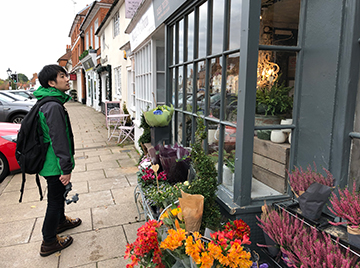
The Vision Design Team members sought to gain a full understanding of the town’s special characteristics and local people’s lives by visiting the local shops, restaurants, post office, library, church, police station, and other facilities, observing the region, and doing interviews as part of the Ethnography* survey we conducted at the time of filming.
Many of the residents spoke of a strong sense of mutual trust in the town. The high street played an important role as a place where people came to confirm local ties and it seemed to be an important element of life in rural towns that local described as “extremely British.”
At the same time, shopkeepers complained that the growth in online shopping and soaring land prices made it difficult to run small shops on the high street and some shops were on the verge of closure due to the decline in the number of people shopping in the area. Recently, a bank closed its branch on the high street and the nearby bus stop was moved further away.
We realized that the regional concerns that the Cycle of Changes seeks to address through ethnography overlapped considerably with the concerns voiced by the people of Odiham.
*Ethnography refers to a research method used to understand the behavior and quality of life of a specific individual or group from the perspective of those involved. Researchers often participate in the community and provide detailed observations and interviews. Ethnography was originally designed as a research method for cultural anthropology and sociology, but is now sometimes used in design research and other fields.
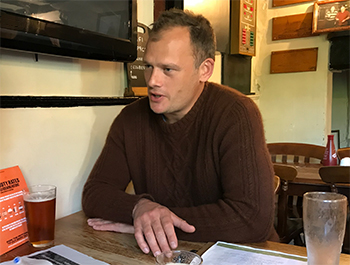
“The high street is different to a large shopping mall. It’s a public space, so we have to consciously choose where we shop in order to keep high street bustling.”
―Nick (architect)
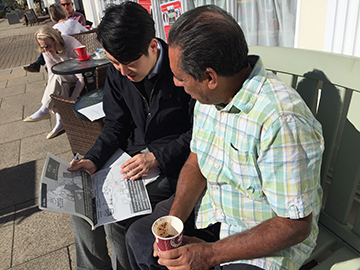
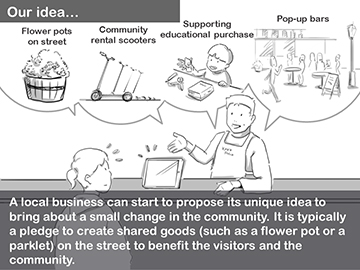
The part of Concept Board
We talked with local people about the Cycle of Change concept while we learned about the current state of community affairs in Odiham. We discussed the significance of the idea in relation to an actual town while looking at a board explaining the concept.
Odiham shopkeepers and residents were positive about the Cycle of Change thinking, which proposes a system for revitalizing towns and cities by enlisting the cooperation of residents and empowering small local stores.
Some local people were not convinced however that the Cycle of Change had any great value. They said they were aware of the local shops’ predicament and they made an effort to shop in the area to support local retailers, so the Cycle of Change wouldn’t make much difference. As a result of these interviews, we realized that the people of Odiham were already implementing the face-to-face economic formats that we were aiming for.
The research and discussion with Odiham locals brought the party scene at the end of the concept video to life. To shoot the video conveying the Cycle of Change concept, we not only hired actors to act out pre-set scenarios, but also interviewed an owner of an Odiham shop, people living in the area, and actresses selected during auditions to try and understand town life and the various challenges that the high street was facing. People from the surrounding area also cooperated with our filming as they sympathized with the ideas we had explained during our interactions on the Cycle of Change concept. We also included simulated situations on the streets of Odiham in the video in which local people were able to create social relationships. In short, we created a vision by intersecting concept and reality for an idea to enrich the town.
These activities represented a valuable opportunity for us to formulate concrete ideas in the context of real-life town problems. At the same time, by participating in the video, we hope the people of Odiham got to enjoy the moment when the vision to overcome their town’s problems became a reality.
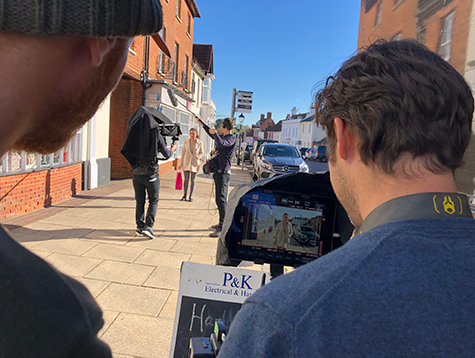
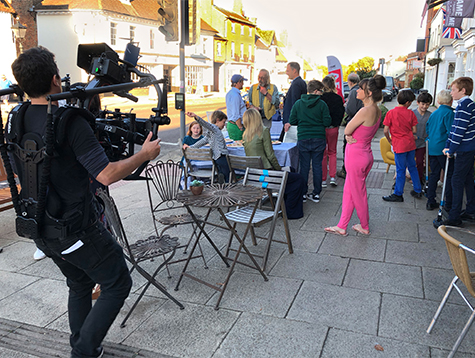
The whole experience of researching life in rural towns in the UK and talking with local people within the Cycle of Change project enabled us to confirm the potential benefit that the concept could bring to real towns and cities. Pursuing field research and dialogue on a design concept enables us to learn things about the challenges of building community trust and revitalizing rural life that we wouldn’t have been able to learn sitting at our desks. It is this real-life context research and dialogue that allows us to shape a new form of design in society. That is the vision of the future that we are seeking to achieve through our Future Living Lab approach.

“I have lived not far from here for 25 years, but it is different from Odiham. We have a big shopping center but there is no community. Even the pub has closed down. I think Odiham represents the way towns and communities should be. Everyone is friendly and easy to get to know. People say a polite good morning even if they just pass each other on the street. If you said hello to someone you didn’t know in London, people would think you were strange. The Cycle of Change is a great idea. It is hard for local people to get together nowadays. I would also like to use this system to create a community in which we all talk to each other and say ‘good morning,’ ‘hello,’ or ‘how’s your day going?’”
―Charlotte (actress)

Koji Sasaki (Senior Researcher)
Masahide Ban (Designer)
Maiko Kaneda (Designer)
Tasuku Soga (Designer)
Vision Design Project, Tokyo Global Center for Social Innovation,
Research & Development Group, Hitachi, Ltd.